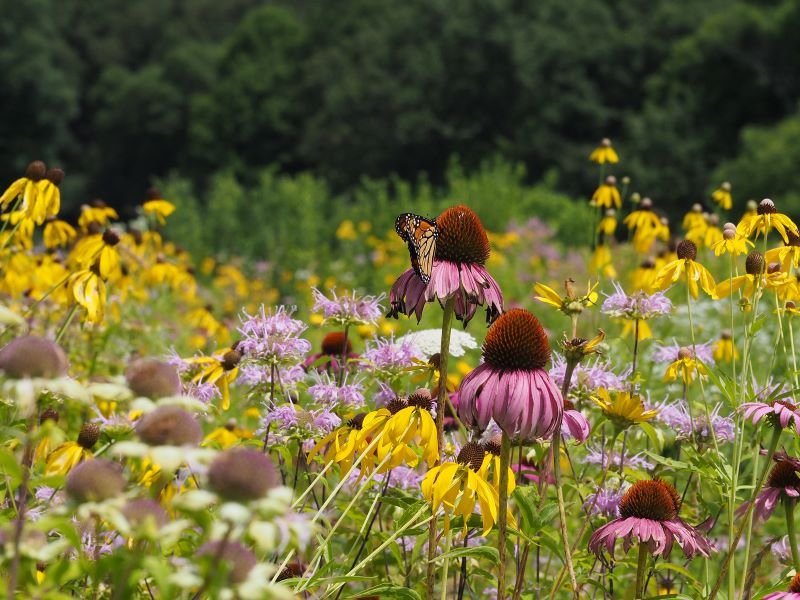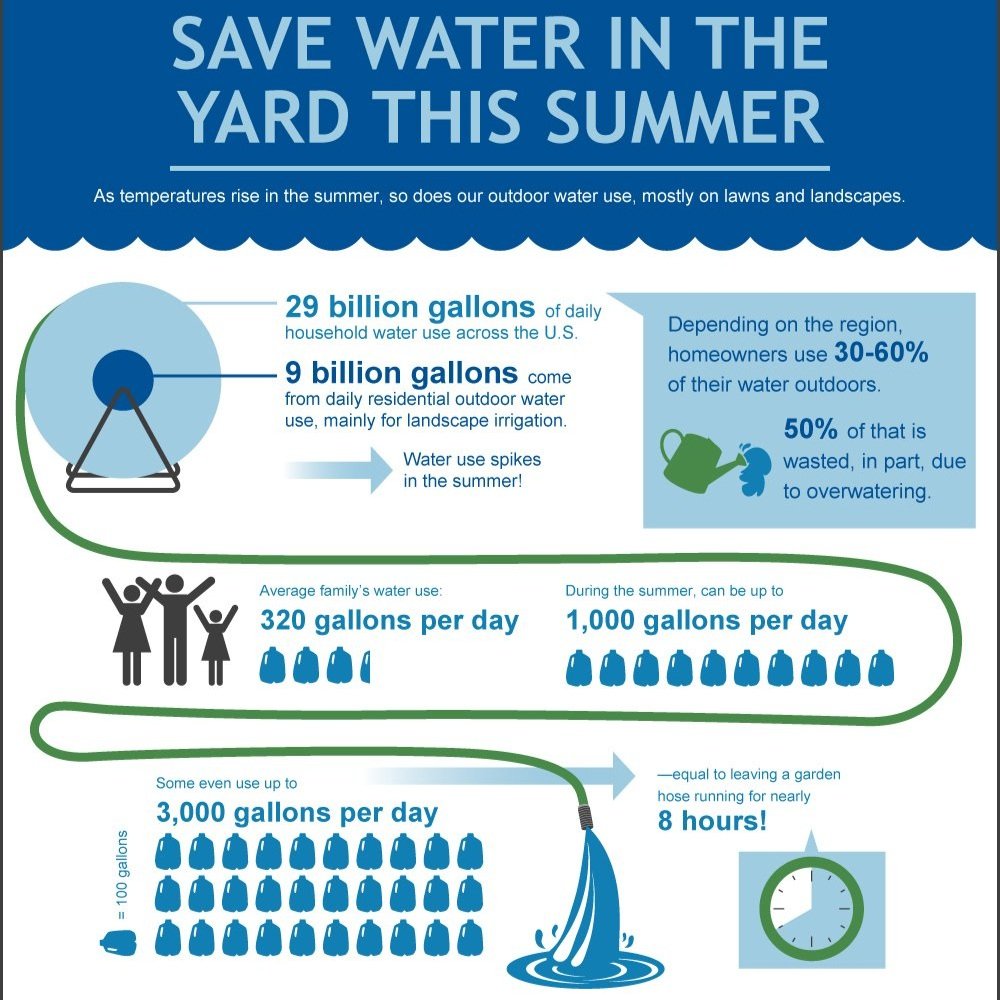7 REASONS YOU SHOULD INCORPORATE NATIVE PLANTS INTO YOUR LANDSCAPE
Did you know that your garden, landscaping, or even a few flower pots on your front porch have a direct impact on climate change and biodiversity?
That’s right!
Over the past 100 years, development and urbanization have reduced intact, healthy ecosystems into fragmented microcosms of what they once were.
What was once an old-growth forest or a wetland is now paved over, filled in, and landscaped with high-input turf grass and, very often, invasive plants that serve no ecological value outside their native range.
Before urbanization, these intact ecosystems were home to thousands of beings, not just flora and fauna, but a vast array of insect life, pollinators, microorganisms, and more wildlife than we can imagine.
Map of Florida from 1881 of pine forests
So, where does your yard fit into all of this?
Since our wild spaces are becoming few and far between, your yard has the potential to be a wildlife oasis in a sea of pavement and turf grass!
If you don’t have much space, incorporating a few native plants in pots can have an enormous impact in helping to save our biodiversity and provide food and refuge for our precious and endangered native pollinators.
Research what natives would be best suited for containers on your patio
Let’s get into it!
What Are Native Plants & Why Are They Important?
According to the Audubon Society, a native plant is a plant that occurs naturally in the region in which it evolved. Here is the definition from the National Wildlife Federation:
“Native plants have formed symbiotic relationships with native wildlife over thousands of years, and therefore offer the most sustainable habitat. A plant is considered native if it has occurred naturally in a particular region, ecosystem, or habitat without human introduction.”
Native Plant resources from the Florida Native Plant Society
Native plants are the ecological basis that life (including humans) depends on and is sustained by.
An ecosystem is a complex web of interdependent elements that have evolved in symbiosis for millennia. Native plants are keystone elements of any ecosystem and play a vital role in maintaining balance and equilibrium. Without them, the whole system can collapse.
Without our native plants, the insects, birds, pollinators, and animals that co-evolved with them cannot survive. The influx of traditional landscaping and a lack of incorporating native species in the landscape are HUGE contributors to biodiversity loss.
Here is an excerpt from an article titled “Why Native Plants Matter” by the Audubon Society.
“For example, research by the entomologist Doug Tallamy has shown that native oak trees support over 500 species of caterpillars whereas ginkgos, a commonly planted landscape tree from Asia, host only 5 species of caterpillars. When it takes over 6,000 caterpillars to raise one brood of chickadees, that is a significant difference.
Unfortunately, most of the landscaping plants available in nurseries are alien species from other countries. These exotic plants not only sever the food web, but many have become invasive pests, outcompeting native species and degrading habitat in remaining natural areas.”
7 Benefits of Incorporating More Native Plants into Your Landscape:
LOW MAINTENANCE
Since native plants evolved in the region they are from, they have evolved to thrive in the local conditions.
Take Florida, for example. Our native plants are acclimated to our dry, cold (ish) winters and our extremely humid, hot, and rainy summers. Additionally, most native plants are drought tolerant, which means they require SIGNIFICANTLY less to no irrigation or any external inputs at all once established.
This is a massive difference from non-native ornamental plants that require lots of fertilizer, pesticides, and copious amounts of water to stay healthy.
WILDLIFE
Typically, the most common ornamental landscaping plants are from Asia. Our wildlife has not evolved alongside these plants; thus, they have no relationship to them. Since urban sprawl has led to a massive decline in wild spaces and individual lawns are covered in turf grass and non-native plants, there is nothing left to sustain the native wildlife populations. In effect, this furthers our biodiversity loss and massively contributes to climate change and ecosystem destruction.
When you plant even a few native plants in your landscape, you are making a huge impact as far as supporting native ecology and wildlife.
While large continuous protected plots of land are essential for wildlife, such as the Florida Wildlife Corridor, even small areas can make a huge impact in providing food and habitat for our at-risk species.
Image courtesy of the Florida Wildlife Corridor Foundation
For example, there are a few native species that are known as ‘keystone’ species, like an Oak tree. As illustrated in the quote above, Oaks are hosts to hundreds of caterpillars. These caterpillars are a vital food source for many of our native birds and other wildlife. Without them, the entire ecosystem suffers.
BEAUTY
Everyone wants a beautiful yard. It’s a part of our nature as humans. Landscaping and gardening are deeply intertwined with our love for beautifying our homes and our relationship to Place.
Native & Florida friendly garden installation by Wacca Pilatka in the Avondale neighborhood of Jacksonville, FL
Native plants have a unique beauty reminiscent of wild spaces that exotic ornamentals lack. Non-native plants, on the other hand, thrive and look best in their native habitat.
You can mimic a peaceful and abundant wildflower meadow in your backyard by planting some native wildflowers, prairie grasses, and other native species that support pollinators, birds, and other beings that depend on these ecosystems to survive.
Image Credit: Agi Kehoe via UF/IFAS Extension Blog
Native plants have an intrinsic beauty that connects us to the land we reside on. Not only are they physically beautiful, but they are also beautiful for their vital role in maintaining intact ecosystems, increasing and restoring biodiversity, and ensuring our survival as a species.
There is something to be said about appreciating a beautiful landscape design while knowing that it is also benefiting our ecosystem.
HEALTHIER OUTDOOR SPACES
Turf grass lawns often need gallons of herbicides, pesticides, and fertilizers to maintain. If you’re a homeowner and care for a turf lawn, you know how much time, money, and labor it takes to keep that grass green.
The sheer amount of chemicals used to maintain a turf lawn creates a hostile environment for both humans and wildlife. More and more studies are coming out showing the connection between terminal diseases like cancer and common pesticides/herbicides like glyphosate.
Are chemical-ridden lawns really a safe space for our children to be playing? Is it worth risking our health for a green lawn that directly contributes to climate change and habitat loss?
The traditional suburban turf lawn has 10x more pesticides per acre than farmland.
Read that again.
When you plant native plants, you are actively creating a healthier environment for you, your family, and your community. Compared to exotic non-native plants and turf lawns, native plants do not require even a fraction of the inputs needed to maintain a lawn or ornamentals.
CLIMATE RESILIENCY
It’s hard to quantify just how much planting native plants helps to build climate resiliency. Mainly because ecosystems are deeply interconnected, exist in a perfect balance (when healthy), and the micro always affects the macro. Thus, the small act of planting a few native plants can make big change.
We’ve established that native plants benefit pollinators and wildlife. However, there are many other ways that planting native plants directly contributes to climate resiliency!
Let’s start with nonrenewable resources first, shall we?
Reducing the use of fossil fuels needed to power mowers and other lawn maintenance equipment will significantly curb pollution and reduce our dependency on non-renewable resources.
Another way that native plants help mitigate climate change is that they often have deep tap roots that capture carbon from our atmosphere and put it back in the earth where it belongs.
Root systems of Non-Native vs. Native Mid-Atlantic Plants. Source: Alliance for the Chesapeake Bay
Native plants are also ecosystem engineers. They uplift the local ecology and create vital habitat and food sources for crucial players (birds and pollinators) that maintain balance and homeostasis in our larger ecosystem.
Additionally, native plants make us more resilient in the face of climate disasters like hurricanes and flooding due to their deep tap roots and ability to hold large amounts of water and prevent erosion.
For example, the loss of a majority of our coastal mangrove population has directly led to more damaging hurricane destruction and erosion.
When we restore our native plants and habitats, we protect our future too.
WATER CONSERVATION
The traditional American lawn uses more water than conventional wheat and corn farmers growing at a commercial level!
Green turf lawns in the US cover more than 40 million acres of land– more than any commercial crop in the US! Millions of gallons of clean water go to irrigating green deserts (turf lawns) each year, and most of that water is wasted and turns into chemical-laden storm runoff that pollutes our waterways. Since native plants are drought tolerant, they require little to no irrigation.
Once established, some native species require zero irrigation as they have co-evolved with the natural seasons and weather of the land they are Indigenous to.
CONNECTION TO THE LAND
Learning about the plants native to the Land you live on naturally brings you closer to your environment and the natural world.
Image credit: Sara Morris
Increasingly, humans are more and more isolated from wild spaces. When we tear down forests to build subdivisions and cover them with turf grasses and non-native plants, we become more and more disconnected from our natural environment.
Disconnection from nature is one of the leading causes of climate change. The corporations that are primarily at fault for polluting, drilling, logging, and causing massive destruction to our planet are functioning from a place of pervasive disconnection from the Land and the Earth that so graciously sustains us.
When we lean in and learn the botany and native plants of our area, we immediately become more connected to our natural surroundings and begin building life-changing relationships with the Land.
Relationships that will sustain our planet for generations to come.
When we are passionate and love and respect something, we are more inclined to protect it at all costs…
Nick Freeman, owner of Wacca Pilatka, in Avondale’s Native Park in Jacksonville, FL
Image Courtesy of Native Plant Horticulture Foundation by Isabella Guttuso
At Wacca Pilatka, our mission is to create sustainable & Florida-friendly landscapes that support the health of our ecosystems, promote biodiversity, and bring people closer to nature.
Ready to take your garden to the next level and start uplifting and protecting ecology and biodiversity?
Click here to connect with our team of experts who can help you embark on your journey to helping our Beloved planet.
Mother Nature will thank you! 🌿



















